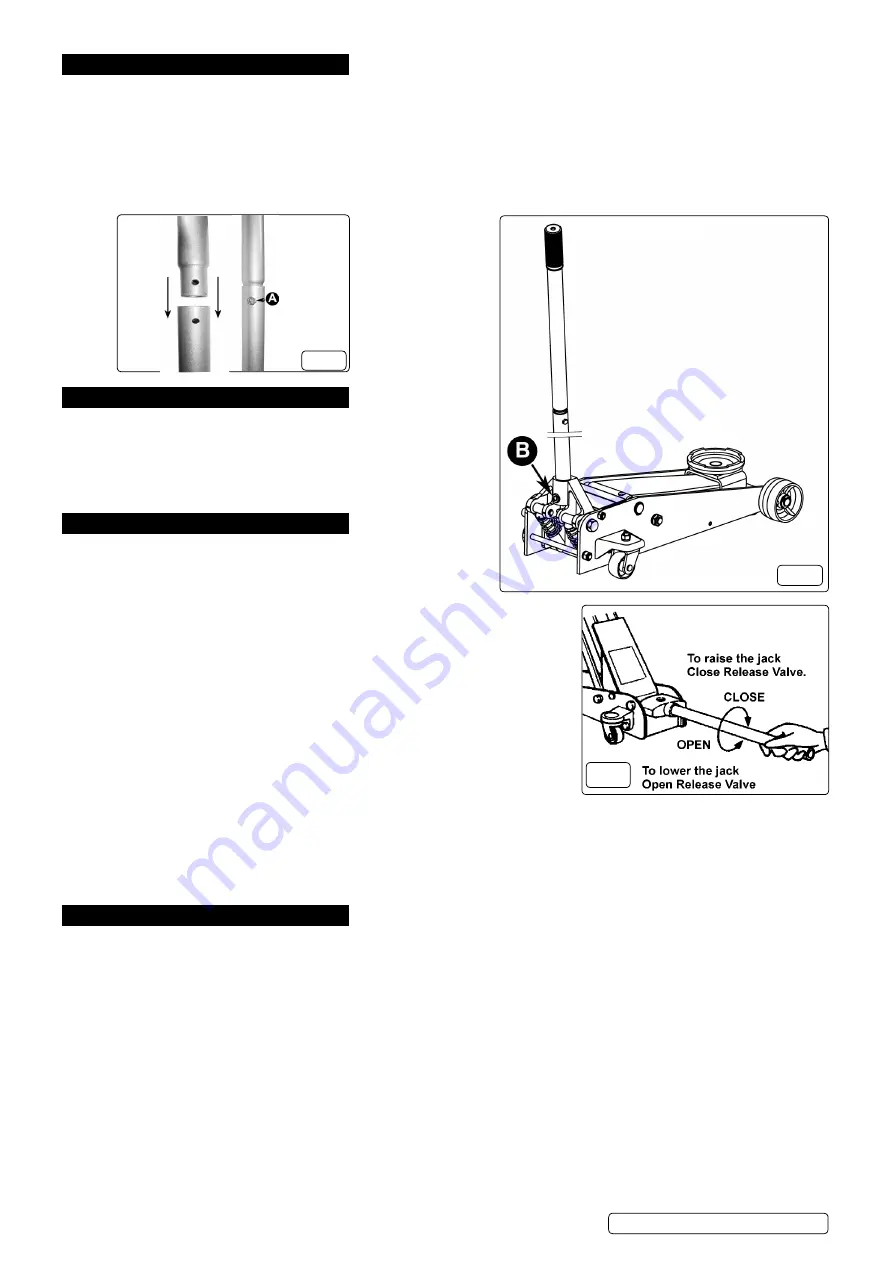
4. aSSeMbly
AssemBlY
4.0.1.
the jack comprises the following parts:
steel chassis.
two-part pumping handle with bolt.
4.0.2.
insert the upper handle into the lower handle. secure the two pieces together with the bolt (A). (fig.1).
4.0.3.
undo the handle socket screw (B) until it no longer protrudes into the handle socket (fig.2).
4.0.4.
insert the pump handle into the handle socket, engaging the square drive of the release valve.
4.0.5.
ensure that the handle is correctly inserted into the socket, then tighten the handle socket screw (B).
5. hyDraulic SySteM purGinG
4.1
open the release valve by turning it one full turn counter-clockwise.
4.2
Pump the handle a minimum eight full strokes.
4.3
close the release valve by turning it clockwise.
6. operation
WarninG!
Before use ensure you have read, understood
and apply section 1 safety precautions.
iMportant:
Before use, the operator is to visually inspect
the jack for cracked welds, damaged or missing parts or hydraulic
leaks.
6.1.
raising a Vehicle
ensure that the jack and the vehicle are on a hard, level surface.
6.1.1.
Always ensure that the vehicle handbrake is engaged and that the
vehicle wheels are chocked.
6.1.2.
consult the vehicle manual to determine the location of jacking points.
Position the jack under a suitable lifting point.
6.1.3.
turn the release valve clockwise, to the closed position (fig.3).
Do not
over-tighten.
6.1.4.
raise the vehicle to the desired height by pumping the handle up and down.
6.1.5.
Place axle stands beneath the locations recommended by the vehicle manufacturer.
6.1.6.
turn the release valve slowly counter-clockwise to lower the vehicle on to the axle
stands.
6.2.
lowering a Vehicle
6.2.1.
turn the release valve clockwise to the closed position.
6.2.2.
Pump the handle to raise the vehicle off the axle stands.
6.2.3.
remove the axle stands from beneath the vehicle.
6.2.4.
turn the release valve slowly counter-clockwise to lower the vehicle to the ground.
note:
When not in use, AlWAYs leave the saddle and ram fully retracted.
7. Maintenance
iMportant:
only fully qualified personnel should attempt maintenance or repair.
7.1.
monthly maintenance
lubrication is critical to jacks, since they support heavy loads. Any restriction due to dirt or rust can cause either slow jack movement,
or extremely rapid jerks, causing damage to the internal components. to keep the jack well lubricated, carry out the following steps.
7.1.1.
lubricate the ram, the linkages and the saddle and pump mechanism with light oil.
7.1.2.
Grease the wheel bearings and axles.
7.1.3.
Keep all jack surfaces and warning labels clean.
7.1.4.
check and maintain the ram oil level (section 7.3).
7.2.
three monthly maintenance
7.2.1.
At three monthly intervals, check the ram for any signs of rust or corrosion. clean the ram as required and wipe with an oil cloth.
7.3.
checking the oil level
7.3.1.
fully retract the ram by turning the release valve counter-clockwise.
7.3.2.
With the jack in the level position, remove the oil filler plug.
7.3.3.
the oil should be level with the bottom of the oil filler hole. if it is not, top up with clean hydraulic jack oil.
7.3.4.
replace the oil filler plug and check the jack operation.
7.3.5.
Purge air from the hydraulic unit as required. refer to section 5.
note:
Always store the jack in the fully lowered position. this will protect critical areas from excessive corrosion.
fig.1
fig.2
3012cXd | issue 2 14/10/16
Original Language Version
© Jack sealey limited
fig.3




















